- Learning time
- 90 minutes
- First play time
- 150 minutes
La Granja
Designed by: Andreas Odendahl,Michael Keller (II)
In La Granja you’re competing farmers in Spain, struggling to establish yourself as the dominant… farmer. Yes, it’s not an epic undertaking, but like the similarly-themed Agricola, that seemingly mild premise hides an intricate, and highly thought-of game.
Each player begins with their own farm in front of them in the form of small player boards. The larger board (representing the market town of Esporles) is placed centrally: the hexagons in the middle are the market and the smaller elements around it are craft buildings. Each player is given a set of pieces in their own colour (these can represent different things, depending on how they are used) and are dealt three cards from the deck.
The game is played over six rounds and with a each round broken into phases: in phase one, everyone plays a card – they can be played in a number of ways: as helpers to assist you, as fields where you grow olives, wheat and grapes. As barrows that, once filled, will be taken to market. And as income, where they may also generate more room for your potentially growing piggery.
Having played a card, everyone generates income and their fields grow crops. If you have two pigs, they produce a piglet. Then – phase two – there is a revenue round, where dice are rolled to decide what actions are available. These are chosen by the players one at a time; they might get you money, or a pig, or an upgrade (turn your crops/pigs into food/wine/bacon) or some other benefit (including pushing you up in turn order (or siesta track), which can be key in La Granja).
Phase three is deliveries: moving one piece from your farm to somewhere else – either into one of your barrows, or a craft building on the board. It’s usually at this point you fill up a barrow, which means it instantly turns into a market stall on the main board, generating points for you and also a bonus trade commodity – essentially, a valuable joker you can cash in at any time in a number of ways. Every player has one of these at the start of the game. If you deliver everything needed by a craft building, you get a healthy reward for that too; they vary from building to building.
Phase four is scoring: you score for your position on the siesta track and your stalls in the market.
So you’re basically developing and building your farm, and taking what you make to the market, where the more impressive stalls (of a higher numeric value) will bump off any lesser value stores they set up next to. But within these phases is a large degree of flexibility. At any point on your turn you can do a number of things: cash in your trade commodity, pay to upgrade your crops or pigs into food/wine/bacon, flip a roof tile over to cash it in. Overall, a game with many things to juggle and a plethora of options – for the right group, a lovely challenge with lots of replayability.
The guru's verdict
-
Take That!
Take That!
Mostly you're working independently, and just as Spanish farmers didn't generally shoot each other with lasers, there's no open combat here. But it is possible to make spoiling moves - both in the market, where you can bump opponent's stalls off the board, and in revenue and delivery stages, beating others to the punch on a wanted die or spot on the board.
-
Fidget Factor!
Fidget Factor!
High on a first couple of plays. Everyone will need time to figure out what they're doing. But it will drop substantially, and two players familiar with the game can play it in under an hour.
-
Brain Burn!
Brain Burn!
Potentially high. Starting with the cards, La Granja offers you a lot of options: just three cards can be used 12 different ways, and it's possible to increase hand size as the game progresses. Cards can be combined in different ways too, and judging your best move can be tricky.
-
Again Again!
Again Again!
If you like the complexity of La Granja, it offers a HUGE amount of variability.

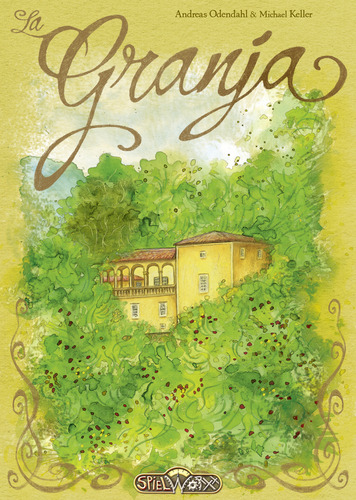
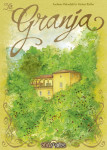
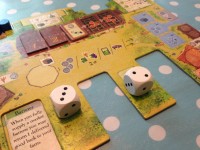
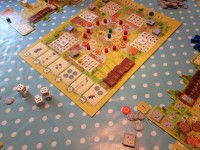
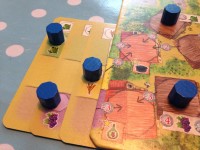


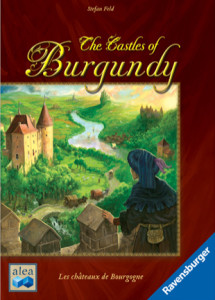
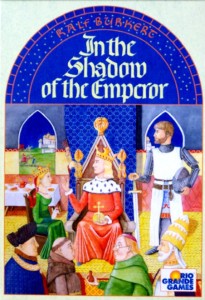
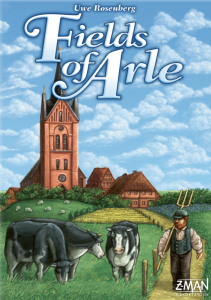
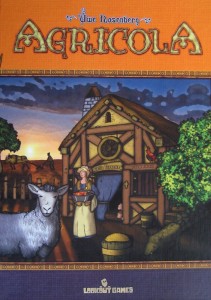
Sam says
The whole thing seems exceedingly complicated on a first play - there's 19 pages of rules - but after that initial, bewildering experience is finished, the myriad of stuff-you-can-do takes on the form of potentially-interlinking things, what's often called engine-building. How will you put these cards to use in a way that combines them beneficially? It's no good having loads of bacon if your market barrow is demanding wine and wheat, as every farmer knows. There's a vast amount of variation here in the cards themselves and potential strategies; and although the game is not dripping with player interaction, if you like something to get your teeth into, La Granja will reward you with lots of variability.